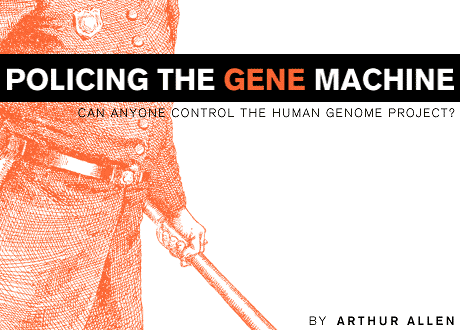
NOW THAT THE NEVADA NUCLEAR-TEST ranges have fallen silent, no other scientific endeavor can match the terrifying allure of the Human Genome Project, the $3 billion, fifteen-year effort to identify and map the 100,000 genes and three billion chemical bits that make up human DNA. The international project was launched in 1988, orchestrated with moon-launch-sized fanfare: The genome would give science the Holy Grail, a blueprint of humanity. Nature was poised to stamp nurture into the dust once and for all. "We used to think our fate was in the stars," trumpeted Nobel laureate James Watson, co-decoder of DNA's double helix. "Now we know, in large measure, our fate is in our genes." For the faint of heart, however, the creation of vast computer banks of human concordance stirred not dreams but nightmares-of designer genes and eugenic ghettoes. "If we are not careful," biotechnology critic Jeremy Rifkin said at the time, "we will find ourselves in a world where the disabled, minorities, and workers will be genetically engineered."Nine years later, scientists are ahead of schedule in compiling what has been called the world's longest, most boring book. Each week scientists document new patterns in the As, Cs, Gs, and Ts (adenine, cytosine, guanine, and thymine-the four building blocks of DNA). They uncover new genes linked to prostate cancer, palsied hands-even neuroticism. The breathless pace of it all seems both wonderful and worrisome. And yet, for anyone who cares to look closely, both the gee-whiz and doomsday metaphors that ushered in the genome project are starting to look seriously out-of-date. For it turns out that we probably won't be able to clone the perfect baby or use genetic screening to eradicate cancer, even if we wanted to. The more we learn about genes, in fact, the more uncertain and ambiguous the whole business gets.
None of which means that genetics has ceased to generate ethical dilemmas-it's just that those dilemmas have turned out to be more immediate and practical than anticipated. For example, several biotech companies now offer tests for recently discovered "disease" genes, though nobody knows yet if such tests can accurately predict if you'll get sick or not. Making matters worse, effective gene therapy is, in most cases, decades away. Fortunately, a structure has been scaffolded onto the genome project to address these types of conflicts head-on. Christened the ELSI Program (for Ethical, Legal, and Social Implications), the ambitious enterprise brings together an unlikely coalition of philosophers, social scientists, and medical professionals. With the genome project-unlike, say, the Manhattan Project or the supercollider-social scientists have been invited inside the temple, not merely as observers but as activists, sworn to assure that what emerges from the laboratory will, at the very least, do no harm.
ODDLY enough, credit for the program's creation goes to none other than James Watson, the grand vizier of the gene. At the October 1988 news conference where he took over as the first leader of the Human Genome Project, Watson announced abruptly-in response to a reporter's heated questioning-that at least 3 percent of the project's budget would go to studying and seeking remedies for the ethical questions that could arise from the new genetics. Was it a P.R. ploy? Perhaps, but it nonetheless was the first time a major scientific enterprise had officially acknowledged the social ramifications of the knowledge it produced.
In a single breath, Watson created the biggest bioethics project of all time. ELSI has spent about eight million dollars a year since 1991, funding college courses, seminars, and more than 150 articles and books, as well as impaneling task forces to wrestle with the prevention of genetic-data abuse. Hundreds of academics have milked the ELSI cash cow, which one wit has described as "Keynesian bioethics." Grants have funded worthy anthologies like Prescribing Our Future, The Code of Codes, and The Genetic Frontier: Ethics, Law, and Policy. WGBH in Boston produced "The Secret of Life," an eight-part PBS series on molecular biology. It's all quite impressive.
And yet, despite this earnest engagement, ELSI's impact on public policy has so far fallen short of its advocates' expectations. Operating under the joint supervision of two agencies-the National Institutes of Health (NIH) and the Department of Energy, which got involved in DNA sequencing in order to find useful postCold War chores for its bomb labs at Los Alamos and Livermore-ELSI consists of a twelve-member Working Group; an extramural research program for social scientists; and an in-house advisory group designed to address ethical issues arising in genetics labs on the NIH campus. ELSI's promise of actually putting "science studies" into action has lured prominent (and often skeptical) voices from that field-including sociologists like UC-Berkeley's Troy Duster, author of Backdoor to Eugenics, and NYU's Dorothy Nelkin, co-author of The DNA Mystique: The Gene as Cultural Icon. Here's the rub, though: ELSI can offer advice, but the scientists aren't required to listen. The Working Group answers to a higher authority, an advisory council led by progress- minded geneticists and administrators. It's this council that has the ultimate power to approve ELSI grants, not to mention the clout to affect whether the Working Group's policy recommendations become reality. So even when ELSI members commit to a fight- to attacking The Bell Curve or the commercialization of genetic testing, for instance-it can seem like a cry in the dark. In this way, say some critics, ELSI has become just what Watson may have been hoping for: a watchdog that's all bark and no bite.
